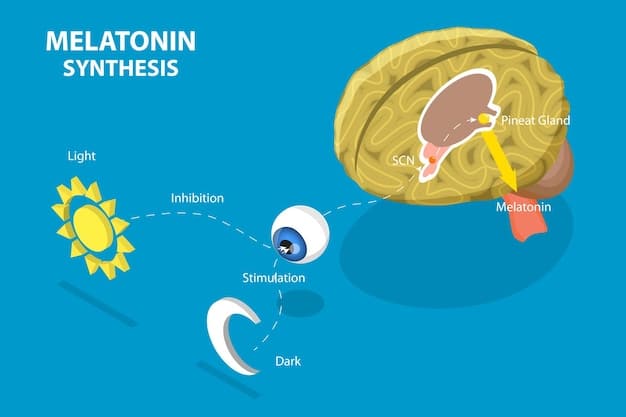Understanding SAD in the US: Guide to Symptoms & Winter 2025 Solutions

Understanding Seasonal Affective Disorder (SAD) in the US: Symptoms and Solutions for Winter 2025 involves recognizing the specific symptoms triggered by reduced sunlight and exploring effective strategies, including light therapy, lifestyle adjustments, and professional support, to manage and alleviate SAD during the winter months.
As winter approaches in the US, understanding and preparing for Seasonal Affective Disorder (SAD) is crucial for maintaining mental wellness. Understanding Seasonal Affective Disorder (SAD) in the US: Symptoms and Solutions for Winter 2025 provides a comprehensive guide to recognizing symptoms and implementing effective strategies to cope with the winter blues.
What is Seasonal Affective Disorder (SAD)?
Seasonal Affective Disorder (SAD) is more than just the “winter blues.” It’s a type of depression related to changes in seasons, typically starting in the fall and continuing into the winter months. Understanding its nature is the first step towards managing its effects.
SAD is characterized by a recurring pattern, appearing and resolving around the same time each year. While the exact causes are still being researched, it’s believed that reduced sunlight exposure during the fall and winter months disrupts the body’s internal clock (circadian rhythm) and can affect levels of serotonin and melatonin, neurotransmitters that play crucial roles in mood regulation.
The Science Behind SAD
Several factors contribute to the development of SAD, including:
- Circadian Rhythm Disruption: Reduced sunlight hours can throw off your internal clock, leading to feelings of fatigue and depression.
- Serotonin Levels: Serotonin, a neurotransmitter associated with mood, is affected by sunlight. Lower sunlight levels can lead to decreased serotonin activity.
- Melatonin Levels: Melatonin, a hormone related to sleep, increases during the winter months, which can lead to feelings of drowsiness and lethargy.

Genetic predisposition may also play a role, with some individuals being more susceptible to SAD than others. Furthermore, people living in regions with significantly shorter daylight hours during winter are at a higher risk.
In summary, Seasonal Affective Disorder (SAD) is a condition linked to seasonal changes, primarily in late fall to early winter, due to the reduction in sunlight. The science behind it includes disturbances in the circadian rhythm, neurotransmitter imbalances of serotonin and melatonin, and possibly even genetic factors.
Recognizing SAD Symptoms
Recognizing the symptoms of SAD is crucial for early diagnosis and treatment. These symptoms can vary in severity from person to person, but often include persistent feelings of sadness and a loss of interest in activities you once enjoyed.
Unlike the temporary sadness that everyone experiences from time to time, SAD symptoms are persistent and debilitating, interfering with daily life and overall well-being. While the patterns of symptoms can vary between individuals, there are certain common indicators that are essential to watch out for.
Common Signs of SAD
Some of the most common symptoms include:
- Persistent Sadness or Depressed Mood: Feeling down, hopeless, or empty for most of the day, nearly every day.
- Loss of Interest or Pleasure: Losing interest in activities you once enjoyed, such as hobbies, social events, or even spending time with loved ones.
- Changes in Appetite or Weight: Significant weight gain or loss due to changes in appetite, often accompanied by cravings for carbohydrates.
- Fatigue and Low Energy: Feeling tired and sluggish, even after getting plenty of sleep.
Additionally, those with SAD may experience difficulty concentrating, irritability, feelings of worthlessness or guilt, and even thoughts of death or suicide. It’s crucial to note that feeling suicidal is a serious symptom that requires immediate medical attention.
In conclusion, recognizing the symptoms of Seasonal Affective Disorder (SAD) is vital for early diagnosis and effective management. Common signs include persistent sadness, loss of interest in activities, significant changes in appetite or weight, fatigue, difficulty concentrating, and in severe cases, suicidal thoughts.
Light Therapy for SAD
Light therapy is a primary treatment for SAD, aiming to compensate for reduced sunlight exposure. It involves sitting near a special light box that emits a bright light, mimicking natural sunlight. Regular use of light therapy can significantly improve SAD symptoms.
The underlying principle behind light therapy is to reset the body’s internal clock and stimulate the production of serotonin. Exposure to bright light, particularly in the morning, can help regulate circadian rhythms and boost mood.
How Light Therapy Works
Key aspects of light therapy include:
- Light Box Specifications: The light box should emit 10,000 lux of light and filter out harmful UV rays.
- Usage Guidelines: Typically, individuals sit in front of the light box for about 20-30 minutes each day, usually in the morning.
- Timing: Consistent daily use is essential, usually starting in the early fall when symptoms begin and continuing until spring when natural sunlight increases.
Light therapy is generally safe, but some people may experience side effects such as headaches, eye strain, or nausea. These side effects are usually mild and temporary. Consulting a healthcare professional before starting light therapy is advised to ensure it’s the right treatment option.

In summary, light therapy is a cornerstone treatment for Seasonal Affective Disorder. It compensates for the reduced sunlight exposure during the winter months by using a special light box that emits bright light to reset the body’s internal clock. Consistent and proper use of light therapy can alleviate SAD symptoms and improve overall well-being.
The Role of Diet and Exercise
Diet and exercise play a crucial role in managing SAD symptoms. A balanced diet can help stabilize mood and energy levels, while regular exercise can boost endorphins, which have mood-enhancing effects. Incorporating both into your daily routine can significantly improve SAD-related challenges.
Proper nutrition provides the body with essential nutrients that support brain function and emotional regulation. Regular physical activity helps reduce stress and improve sleep, further contributing to mental well-being.
Dietary Recommendations for SAD
For individuals with SAD, consider these dietary recommendations:
- Vitamin D-Rich Foods: Include foods rich in vitamin D, such as fatty fish, fortified milk, and eggs, as vitamin D deficiency is linked to depression.
- Omega-3 Fatty Acids: Consume omega-3 fatty acids found in fish, flaxseeds, and walnuts, which are known for their mood-boosting properties.
- Complex Carbohydrates: Choose complex carbohydrates like whole grains, fruits, and vegetables over simple sugars to stabilize blood sugar levels and prevent mood swings.
Regular exercise, such as brisk walking, jogging, swimming, or cycling, can elevate mood and reduce feelings of fatigue. Aim for at least 30 minutes of moderate-intensity exercise most days of the week.
To sum up, diet and exercise are essential components in managing Seasonal Affective Disorder. Adopting a balanced diet rich in vitamin D, omega-3 fatty acids, and complex carbohydrates, along with engaging in regular physical activity, can improve mood, boost energy levels, and help mitigate the symptoms of SAD.
Medication and Therapy Options
Medications and therapy are viable options for treating SAD, especially in more severe cases. Antidepressants, particularly selective serotonin reuptake inhibitors (SSRIs), can help regulate mood. Cognitive-behavioral therapy (CBT) can provide coping strategies and change negative thought patterns.
Medications work by adjusting the balance of neurotransmitters in the brain, while therapy focuses on equipping individuals with tools to manage their symptoms and improve their overall mental health.
Exploring Treatment Approaches
Consider the following approaches to treatment:
- Antidepressants: SSRIs can help increase serotonin levels, which are often reduced in people with SAD.
- Cognitive-Behavioral Therapy (CBT): CBT techniques help individuals identify and challenge negative thought patterns and behaviors related to SAD.
- Combination Treatment: Combining medication and therapy can offer the most comprehensive approach for managing SAD.
Medication can alleviate symptoms such as sadness, fatigue, and loss of interest; however, they may also have side effects that need to be carefully monitored. Therapy, on the other hand, teaches coping mechanisms and addresses underlying issues, resulting in more sustained improvements.
In summary, both medication and therapy provide effective treatment options for Seasonal Affective Disorder. Antidepressants can help regulate neurotransmitters, while cognitive-behavioral therapy equips individuals with coping strategies to manage symptoms and change negative thought patterns, providing a comprehensive approach to SAD treatment.
Lifestyle Adjustments for Managing SAD
Lifestyle adjustments are proactive measures that can significantly alleviate SAD symptoms. Simple changes to daily routines can create a positive impact on mental well-being. These adjustments can foster a more balanced outlook when dealing with SAD.
Small alterations in daily habits can boost mood, increase energy levels, and enhance overall quality of life. Incorporating these adjustments into your routine can make a noticeable difference.
Practical Lifestyle Changes
Consider the following practical lifestyle changes:
- Maximize Sunlight Exposure: Spend time outdoors during daylight hours, even if it’s cloudy. Open curtains and sit near windows when indoors.
- Maintain a Regular Sleep Schedule: Go to bed and wake up at the same time each day to regulate your body’s internal clock.
- Engage in Social Activities: Stay connected with friends and family to avoid feelings of isolation and loneliness.
Being proactive helps you feel more in control. Socializing and maintaining connections are essential for combating feelings of isolation. These small but meaningful changes can make a significant impact on your mental well-being during the winter months.
In conclusion, lifestyle adjustments are vital for managing Seasonal Affective Disorder. Maximizing sunlight exposure, maintaining a regular sleep schedule, and engaging in social activities can alleviate symptoms and foster a more balanced state of mind. These strategies can improve the quality of life and help you navigate the challenges of SAD during the winter months.
| Key Point | Brief Description |
|---|---|
| ☀️ Sunlight & SAD | Reduced sunlight disrupts circadian rhythm, affecting mood. |
| 💡 Light Therapy | Mimics natural light, can improve mood by regulating serotonin. |
| 🥗 Diet & Exercise | Balanced meals and regular activity boost endorphins and stabilize energy. |
| 🤝 Social Engagement | Staying connected helps prevent isolation and improves mental health. |
Frequently Asked Questions (FAQ)
▼
The main symptoms of SAD include persistent sadness, loss of interest in activities, changes in appetite or weight, fatigue, and difficulty concentrating. These symptoms typically occur during the fall and winter months.
▼
Light therapy uses a special light box to mimic natural sunlight. It helps regulate the body’s internal clock and stimulates the production of serotonin, a neurotransmitter that helps to improve mood.
▼
Yes, a balanced diet rich in vitamin D and omega-3 fatty acids, combined with regular exercise, can help stabilize mood and increase energy levels, thus alleviating symptoms of SAD.
▼
Selective serotonin reuptake inhibitors (SSRIs) are commonly prescribed to treat SAD. These medications increase serotonin levels in the brain, which helps to regulate mood and reduce depressive symptoms.
▼
Lifestyle adjustments, such as maximizing sunlight exposure, maintaining a regular sleep schedule, and engaging in social activities, can significantly reduce feelings of isolation and improve overall well-being during the winter months.
Conclusion
Understanding Seasonal Affective Disorder (SAD) in the US: Symptoms and Solutions for Winter 2025 equips individuals with the knowledge and tools necessary to navigate the challenges of winter-related mood changes. By recognizing symptoms, exploring effective treatments such as light therapy and medication, and incorporating lifestyle adjustments, it is possible to manage and alleviate SAD, promoting mental wellness throughout the winter season.





